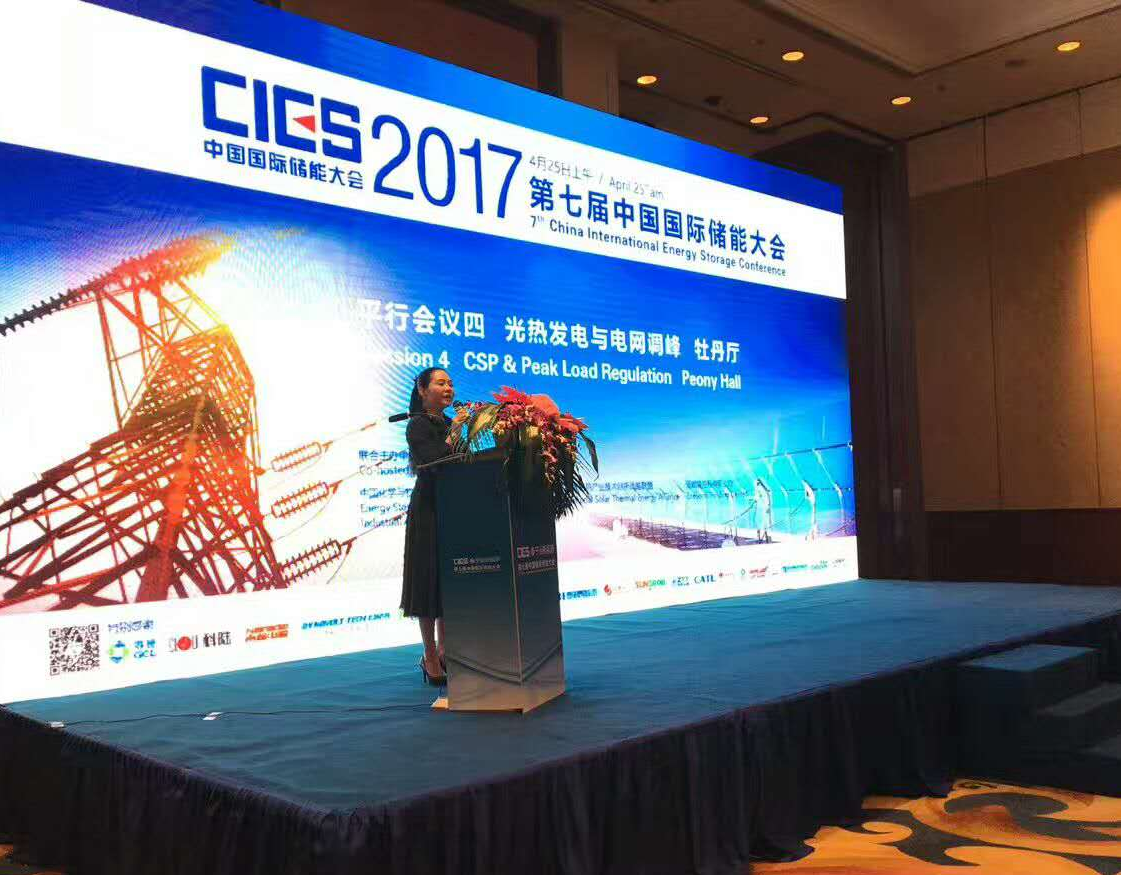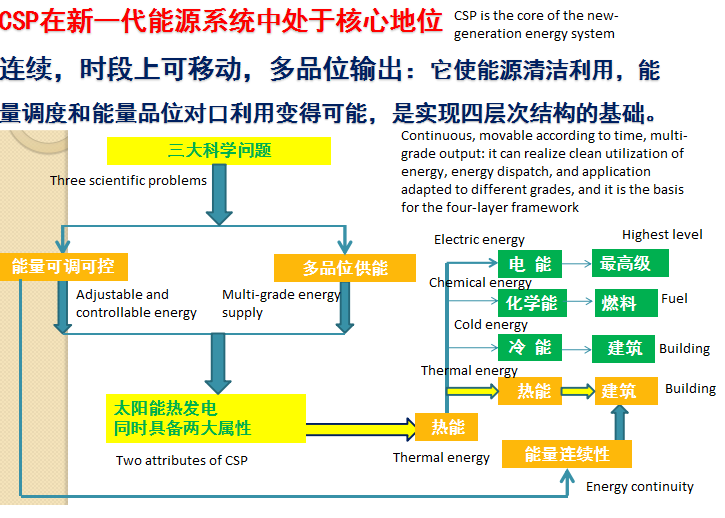China has ushered in an upsurge in the establishment of concentrating solar power (CSP) projects in 2017, since it published the benchmark electricity price for CSP and determined the first batch of demonstrative projects in 2016. However, while national policies start to support the CSP industry, wind and solar curtailment become more and more obvious in the “three-north”regions. How can we solve the conflict? Insiders believe: energy storage is a key method to reduce wind and solar curtailment and guarantee healthy development of power generation with renewable energy, including CSP. As CSP is equipped with thermal storage systems, electricity that it produced should be of high quality as to the power grid.
In the morning of April 25, the “CSP & Peak Load Regulation” forum, jointly sponsored by China National Solar Thermal Energy Alliance, Energy-storage Application Branch of China Industrial Association of Power Sources, and Enesoon Holdings Ltd, was held ceremoniously in Suzhou Shangri-La Hotel. Famous experts and scholars in the industry, from Shenzhen Enesoon Science and Technology Co., Ltd, New Energy Department of China Renewable Energy Engineering Institute, New Energy and Statistics Research Department of State Grid Energy Research Institute, New Energy Research Center of China Electric Power Research Institute, College of Energy Engineering of Zhejiang University, College of Material Science of Wuhan University of Technology, and North China Electric Power University, gathered together to communicate with each other about topics such as CSP’s role in the power grid, orientation of CSP in the new-generation energy system, and energy storage techniques. The conference was hosted by Chen Mingli, Chairwoman of Shenzhen Enesoon Science and Technology Co., Ltd.

Chen Mingli hosted the CSP & Peak Load Regulation forum
1. CSP is the technology that may truly convert our power grid into energy Internet
The report “Orientation of CSP in the New-generation Energy System”, prepared jointly by Wang Zhifeng, Executive Vice Chairman of China National Solar Thermal Energy Alliance, and Xiao Gang, a doctoral supervisor of Zhejiang University, points out: core status of the renewable energy in the new-generation energy system should be firstly established before functions of CSP can be well determined. As fluctuant renewable energy power is a new challenge to the power grid, when large-scale new-energy power serves as the distribution source of electric power transmission, it is necessary to flexibly and effectively connect such power to the grid for transmission so as to integrate it into the power development. New situations require that the power grid should satisfy demand at the user side in various periods, according to different peak loads and with alternate use of different renewable energy resources, without any influence on the user side due to instable power supply by a certain renewable energy resource. How to reconcile the need conflict between the supply side and the demand side at different time? The CSP technology, together with relevant thermal storage techniques, can not only guarantee the stability and smoothness of power supply but also reduce costs in power generation, which is the best selection for smooth running of a new-generation energy system.

The report points out: currently, CSP systems with thermal storage enjoy enough cost advantages, compared with photovoltaic power generation systems with thermal storage. In the next 20 years, even though thermal storage techniques fail to have breakthroughs or revolutionary changes, the cost of CSP systems with thermal storage will be equivalent to that of photovoltaic systems with thermal storage. In other words, CSP systems with thermal storage, even without any revolutionary change in the next 20 or 30 years, will still be able to fully compete with photovoltaic systems with thermal storage. Besides, from the perspective of energy gradient utilization, CSP can also be coupled with heat and cold supply techniques. Thus, CSP systems can bring higher energy efficiency and lower overall economic cost. Therefore, CSP is possible to change our power grid into an energy network, or energy Internet, in a real sense.
This is a technical requirement that our new-generation system has placed on CSP. We hope in the following 20 or 30 years we will make the technology completely mature with lowest cost. Therefore, CSP should work as the mainstay of the whole new energy field. Even though the mainstay is not influential yet, we hope it will become more and more dominant.
2. CSP can truly play an important role in power planning and balance
Xie Guohui, Deputy Director of New Energy and Statistics Research Department of State Grid Energy Research Institute, pointed out in the keynote speech “Orientation of CSP in the Power Grid”: I myself have great confidence in CSP. Firstly, CSP is another technology to generate power with solar energy, in parallel with photovoltaic power generation. In 2016, the accumulated installed capacity of photovoltaic power generation reached 77.42 million KW and the newly increased installed capacity of it exceeded that of wind power for the first time, which was a landmark event. As CSP is just started, its future is promising. Secondly, consider about the status of CSP through newly increased electric quantities. Since 2015, CSP has worked as an alternative power source in the energy structure. As the trend goes on, newly increased power output of CSP will exceed that of the coal power before 2025, which will be another landmark event, indicating a very important role that CSP will play in the future energy-supply system.
Moreover, intermittent power supply without energy storage will cause serious influences on power grid planning, when a large scale of it is connected to the power grid. By statistics, we find that during a peak power load period with the confidence level of 95%, confidence coefficient of photovoltaic power capacity is just around 25%. In other words, during such peak time, for a photovoltaic power station with capacity of a million, only 250 thousand of it can be used in power grid planning, because of power balance. However, as to CSP, if thermal storage of 6 hours is provided, it can continue to generate power during evening peaks. Therefore, from the perspective of power planning and balance, CSP can truly play an important role.
In a word, functions of CSP in the power grid can be defined as follows: in the case of a small grid-connected scale, CSP can be used for peak load regulation, supporting the photovoltaic and wind power generation to meet the needs of system peak load and frequency regulation; when the grid-connected scale grows bigger and bigger, it is entirely possible for CSP to replace nuclear power and static hydropower in power systems. As to value of CSP, the National Renewable Energy Laboratory of the United State conducted a research experiment to compare photovoltaic power generation, wind power generation, CSP without thermal storage and CSP with thermal storage. Experimental results show that CSP can not only replace high-cost generator units but also reduce the number and relevant cost of generator starts and stops, decrease emission of harmful gas, improve capacity benefit at peak time, and cut marginal expenses of the whole system. Therefore, CSP has higher value, basically about 20% more than that of the photovoltaic power generation. And, I think highly of CSP’s value and functions in power systems in the future.
3. The development of CSP helps to improve the overall accommodation capacity of new energy
Zhu Lingzhi, Deputy Chief Engineer of New Energy Research Center of China Electric Power Research Institute, made a speed regarding “CSP and power grid regulation”. He pointed out: in recent years, wind curtailment and solar (photovoltaic) curtailment have always been hot topics concerned in the field of new-energy power generation in China. Why so many new energy sources are abandoned, even with considerable electric quantity? There are probably three technical reasons: the first one is about the accommodation space for new energy as well as the transmission capacity of the power grid. New energy has developed unconventionally fast, and its proportion in some local areas is excessively high, beyond the market demand. The second one is the system regulating ability. The flexibility to regulate the proportion of electric sources, pumped storage power and fuel gas power is low; the ability to regulate thermal power is not sufficient, and thermal power generating units in the “three-north” regions only have regulating capacity of 20% during heat-supply periods. By comparison, thermal power generating units in countries such as Spain and Denmark are prepared with in-depth peak load regulation, with adjustable output accounting for 80%. The third one is the grid-connected adaptability of new energy. The connection of new energy power, wind power and photovoltaic power into the power grid needs quite different technology from conventional techniques. It lacks of inertial characteristics and has weak frequency support strength. Its high proportion lowers anti-disturbance capability of the power grid. Due to the connection of new energy, frequency characteristics of the system deteriorate a lot. “Wind and solar curtailment” will be a major problem China has to face in a long period of time, especially in western areas suitable for the development of CSP.
CSP is a new force in power generation with new energy. Through thermal storage techniques, CSP can achieve 0 to 12 hours of energy storage, while photovoltaic power generation or wind power generation itself doesn’t have the storage function. As to output fluctuation, CSP can provide relatively continuous and steady output, while photovoltaic power generation has bigger and wind power generation has even much bigger fluctuation in output. As to the system stability, firstly, CSP, working as a synchronous power generator, has many advantages: it increases system inertia, produces stable frequency and improves anti-disturbance capacity of the power grid. Besides, CSP can enhance the short circuit current level and the fault tolerance, and strengthen voltage stability of the sending end grid to avoid cascading failure. Thirdly, CSP can improve the quality of power energy in regions where it is connected, to suppress synchronous oscillation. CSP with bigger capacity of thermal storage can effectively improve system peak load regulation to remit power limiting problem of new energy. Of course, power limiting may be conducted as to CSP with insufficient capacity of thermal storage.
CSP has good grid-connected adaptability and is able to improve system stability in regions where new energy is intensively developed. In this respect, the development of CSP may also need supports of a series of supporting service policies, except the electricity price policy. For example, CSP can assist wind power or photovoltaic power in peak regulation to improve system stability in local areas. Therefore, can CSP obtain certain additional compensation from such wind power and photovoltaic power enterprises to improve its own benefits and competitiveness? It is probably a question that deserves further research and discussion.
In conclusion, CSP can not only work as peak regulating power sources to promote compatibility and coordination between solar energy or wind energy and the power grid to improve the flexibility of new energy supply, but also work as fundamental electric power to play an important role in the power reform. CSP has a promising future, and as time goes on, the installation proportion of CSP will be definitely higher and higher.
(Reported by: Dong Qingfeng)


